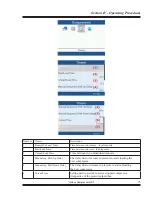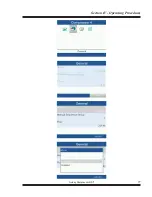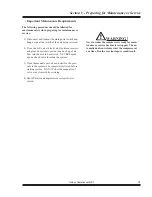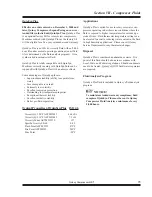
Section VI - Servicing
Quincy Compressor-QSI
®
83
• Safety
• Water Removal
• Air/Fluid Separator Element
• Fluid Scavenging System
• Air Filter
• Control Line Air Filter
• Shaft Seal
• Air and Fluid Tubing
• O-ring Fittings
Safety
NOTICE!
Maintenance should be performed by trained and
qualified technicians only.
Safety procedures while servicing the compressor are
important to both the service personnel and to those who
may be around the compressor and the system it serves.
Listed below are some, but not all, procedures that should
be followed:
•
Wait for the unit to cool before starting service.
Temperatures may exceed 180°F when the compres-
sor is operating.
•
Clean up fluid spills immediately to prevent slipping.
•
Loosen, but do not remove, flange or component
bolts. Carefully pry apart to be sure there is no
residual pressure before removing bolts.
•
Never use a flammable solvent such as gasoline or
kerosene for cleaning air filters or compressor parts.
•
Safety solvents are available and should be used in
accordance with their instructions.
CAUTION!
Unusual noise or vibration indicates a problem.
Do not operate the compressor until the source
has been identified and corrected.
Water Removal
Water vapor may condense in the reservoir and must be
removed. The frequency with which water must be re
-
moved is determined by the ambient air conditions. Dur
-
ing hot and humid conditions, water should be drained
off the bottom of the reservoir daily. In cold and dry
conditions, water may only need to be drained weekly.
To drain water from the reservoir, turn the compressor
off and let sit for at least 5 minutes. Then open the drain
valve. Water is heavier than the compressor fluid and will
collect at the bottom of the reservoir. When the drain is
first opened some compressor fluid may come out before
the water starts to flow. Close the valve when the water
flow changes to compressor fluid. Make certain that there
is no pressure in the reservoir before opening the drain
valve. Water content in the compressor fluid in excess of
200 PPM could cause bearing damage and airend failure.
Air/Fluid Separator Element
The separator element is a one piece construction that co-
alesces the fluid mist, passing through the filtering media,
into droplets that fall to the bottom of the separator ele-
ment to be picked up by a scavenging tube and returned
to the compressor. Use care when handling the separa
-
tor element to prevent it from being damaged. Denting
may destroy the effectiveness of the filtering media and
result in excessive fluid carryover. Even a very small
hole punctured through the element will result in a high
fluid carryover. Larger models use two air/fluid separator
elements.
Summary of Contents for QSI Series
Page 2: ......
Page 7: ...Section I General Quincy Compressor QSI 5 MODEL IDENTIFICATION...
Page 62: ...Section IV Operating Procedures 60 Quincy Compressor QSI 1 Week Timer 2 Remaining Running Time...
Page 79: ...Section IV Operating Procedures Quincy Compressor QSI 77...
















































